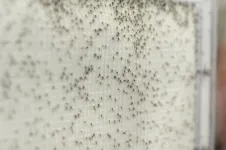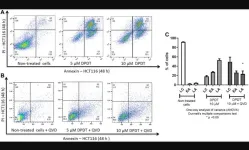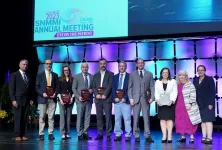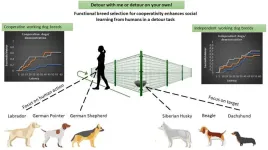(Press-News.org) University of Calgary researchers have discovered how Leishmania parasites hide within the body to cause Leishmaniasis. The tiny parasites are carried by infected sand flies. Considered a tropical disease, one to two million people in more than 90 countries are infected every year. Effects range from disfiguring skin ulcers to enlarged spleen and liver and even death.
This chronic disease has been difficult to detect in the early stages. Scientists realized that the parasite was somehow manipulating immune cells but this process had not been well understood.
“This is the first study that shows how the parasite stalls the process of regular neutrophil cell death which prevents the immune system from being activated,” says Dr. Nathan Peters, PhD, associate professor, at the Cumming School of Medicine (CSM) and principal investigator.
Neutrophils are a type of white blood cell which are the body’s first line of defense against infection and disease. Researchers in the Peters lab found that the parasite targets a receptor on the surface of the neutrophil to gain access inside the cell. Once there the parasite resists the neutrophils’ pathogen-killing molecules.
“The neutrophil then acts like a little Trojan Horse,” says Peters. “The parasite finds a niche inside these neutrophils and makes the neutrophil look like it is a regular dying cell, a process that happens constantly and therefore doesn’t activate the immune system”.
The parasite stalls the process of cell death in the neutrophil, enabling the parasite to persist inside the immune cell and establish infection. Experimental vaccines aimed at preventing the infection haven’t been effective.
“The parasite’s behaviour interferes with our ability to vaccinate, because the immune system isn’t even aware that the parasite is there,” Peters says.
This research, conducted in mice, took place in a highly specialized laboratory, called the Insectary. This space within the Peters’ lab enables researchers to raise sand flies infected with the Leishmania parasite.
“Understanding the earliest interactions between the parasite and the host helps explain why previous vaccination strategies against Leishmaniasis have been unsuccessful,” says Adam Ranson, first author. “Our findings will contribute to bringing researchers closer to developing an effective vaccine against Leishmania infection.”
The study was highlighted as a ‘Top Read’ in The Journal of Immunology.
END
UCalgary study provides insight into how an infectious parasite uses immune cells as a Trojan Horse
Findings could bring researchers closer to developing an effective vaccine against Leishmania
2023-06-26
ELSE PRESS RELEASES FROM THIS DATE:
Poop and prey help researchers estimate that gray whales off Oregon Coast consume millions of microparticles per day
2023-06-26
CORVALLIS, Ore. – Oregon State University researchers estimate that gray whales feeding off the Oregon Coast consume up to 21 million microparticles per day, a finding informed in part by poop from the whales.
Microparticle pollution includes microplastics and other human-sourced materials, including fibers from clothing. The finding, just published in the journal Frontiers in Marine Science, is important because these particles are increasing exponentially and predicted to continue doing so in the coming decades, according to researchers Leigh Torres and Susanne Brander.
Microparticle pollution is a threat to the health of ...
A smarter way to monitor critical care patients
2023-06-26
Surgical and intensive care patients face a higher risk of death and longer hospital stays because they are susceptible to both hypotension and hemodynamic instability – or unstable blood flow.
These potential complications require round-the-clock monitoring of several cardiac functions by nurses and physicians, but there’s currently no singular, convenient device on the market that can measure the most vital aspects of a patient’s cardiovascular health.
Ramakrishna Mukkamala, professor of bioengineering at the University of Pittsburgh Swanson School of Engineering, and Aman Mahajan, ...
DPDT anticancer activity in human colon cancer HCT116 cells
2023-06-26
“Altogether, our results show that DPDT preferentially targets HCT116 colon cancer cells likely through DNA topoisomerase I poisoning.”
BUFFALO, NY- June 26, 2023 – A new research paper was published in Oncotarget's Volume 14 on June 21, 2023, entitled, “Diphenyl ditelluride anticancer activity and DNA topoisomerase I poisoning in human colon cancer HCT116 cells.”
Diphenyl ditelluride (DPDT) is an organotellurium (OT) compound with pharmacological properties, including antioxidant, antigenotoxic and antimutagenic activities when applied at low concentrations. However, ...
Society of Nuclear Medicine and Molecular Imaging announces 2023 fellows
2023-06-26
Chicago, Illinois – The Society of Nuclear Medicine and Molecular Imaging recognized ten new SNMMI Fellows today during a plenary session at the society’s 2023 Annual Meeting, held June 24-27. The SNMMI Fellowship was established in 2016 to recognize distinguished service to the society as well as exceptional achievement in the field of nuclear medicine and molecular imaging. It is among the most prestigious formal recognitions available to long-time SNMMI members.
In keeping with tradition, SNMMI’s 2022-23 president, Munir Ghesani, MD, FACNM, FACR, Mount Sinai Hospital, New York, ...
Purdue-launched solid rocket motor-maker Adranos flies off with Anduril
2023-06-26
WEST LAFAYETTE, Ind. – Adranos Inc., a Purdue-originated company that grew from a doctoral project into an impactful company, has been acquired by a major Costa Mesa, California-based defense products company, Anduril Industries.
Terms of the deal were settled, and the acquisition was announced on Sunday (June 25) in The Wall Street Journal that Anduril Industries is to purchase Adranos, manufacturer of solid rocket motors and maker of ALITEC, a high-performance solid rocket fuel that gives greater payload capacity, range and speed to launch systems.
“The success of Adranos is the latest manifestation ...
Webb makes first detection of crucial carbon molecule
2023-06-26
A team of international scientists has used NASA’s James Webb Space Telescope to detect a new carbon compound in space for the first time. Known as methyl cation (pronounced cat-eye-on) (CH3+), the molecule is important because it aids the formation of more complex carbon-based molecules. Methyl cation was detected in a young star system, with a protoplanetary disk, known as d203-506, which is located about 1,350 light-years away in the Orion Nebula.
Carbon compounds form the foundations of all known life, ...
Despite environmental trade-offs, dairy milk is a critical, low-impact link in global nutrition
2023-06-26
Philadelphia, June 26, 2023 – Along with all global sectors, the dairy industry is working to reduce its environmental impact as we look toward a shared 2050 net zero future. Research is currently focused on greenhouse gas mitigation strategies that do not compromise animal health and production, but many discussions maintain that a radical transformation—involving reducing animal-based foods and increasing plant-based foods—is needed in our agriculture production systems in order ...
Would you detour with me? – Well, that depends on the dog breed!
2023-06-26
A new study from the Department of Ethology, Eötvös Loránd University, showed that dogs may not equally benefit from observing the ‘helpful action’ of a human demonstrator in the classic detour around a V-shaped fence task.
Those who are experienced with the world of ethological conferences, know all too well that if you present your work about dog behavior, the first (or second) question from the audience will be: “And did you check whether the breed of the dog had an effect on your results?”
Actually, this is not surprising as most people are familiar with the mindboggling variability of hundreds of ...
UCLA researchers uncover potential biomarkers of positive response to immunotherapy
2023-06-26
FINDINGS
Scientists at the UCLA Jonsson Comprehensive Cancer Center have identified potential new biomarkers that could indicate how someone diagnosed with metastatic melanoma will respond to immunotherapy treatment.
The researchers found when T cells are activated, they release a protein called CXCL13, which helps attract more B cells and T cells to the tumor site. The B cells then show the T cells specific parts of the tumor, which leads to increased activation of the T cells and their ability to fight the cancer. This cooperation between T cells and B cells was associated with improved survival in patients diagnosed with metastatic melanoma ...
American Dental Association releases new tooth decay treatment guideline
2023-06-26
CHICAGO, June 26, 2023 – A new American Dental Association (ADA) clinical practice guideline suggests conservative methods to treat tooth decay in primary and permanent teeth could lead to better outcomes when used with common restorative materials like fillings or caps. An expert panel of dentists developed the first-ever guideline on this topic after extensive review of approximately 300 published studies.
The guideline, published in the July issue of The Journal of the American Dental Association, contains 16 recommendations regarding treatment ...
LAST 30 PRESS RELEASES:
New modeling approach sheds light on rare gut disease
Study documents potentially hazardous flame retardants in firefighter gear
Can certain bacteria regulate aging of the immune system and its related alterations?
AI model helps diagnose often undetected heart disease from simple EKG
There are fewer online trolls than people think
Cell membrane fluctuations produce electricity
Jeonbuk National University study shows positive parenting can protect adolescents against self-harm
Surface-engineered ZnO nanocrystals to tackle perfluoroalkyl substance contamination
This new understanding of T cell receptors may improve cancer immunotherapies
A new fossil face sheds light on early migrations of ancient human ancestor
A new immunotherapy approach could work for many types of cancer
A new way to diagnose deadly lung infections and save lives
40 percent of MRI signals do not correspond to actual brain activity
How brain-inspired algorithms could drive down AI energy costs
Gum disease may be linked to plaque buildup in arteries, higher risk of major CVD events
Contrails are a major driver of aviation’s climate impact
Structure of dopamine-releasing neurons relates to the type of circuits they form for smell-processing
Reducing social isolation protects the brain in later life
Keeping the heart healthy increases longevity even after cancer
Young adults commonly mix cannabis with nicotine and tobacco
Comprehensive review illuminates tau protein's dual nature in brain health, disease, and emerging psychiatric connections
Book prepares K-12 leaders for the next public health crisis
Storms in the Southern Ocean mitigates global warming
Seals on the move: Research reveals key data for offshore development and international ecology
Sports injuries sustained during your period might be more severe
World's first successful 2 Tbit/s free-space optical communication using small optical terminals mountable on satellites and HAPS
Can intimate relationships affect your heart? New study says ‘yes’
Scalable and healable gradient textiles for multi‑scenario radiative cooling via bicomponent blow spinning
Research shows informed traders never let a good climate crisis go to waste
Intelligent XGBoost framework enhances asphalt pavement skid resistance assessment
[Press-News.org] UCalgary study provides insight into how an infectious parasite uses immune cells as a Trojan HorseFindings could bring researchers closer to developing an effective vaccine against Leishmania







